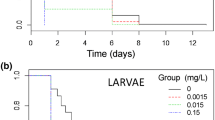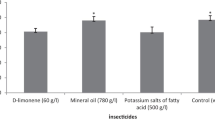Abstract
The toxicity of K-Othrine, an insecticide containing a synthetic pyrethroid derivative (deltamethrin) as an active ingredient, was studied on the pond snail, Lymnaea stagnalis L. This insecticide is used for the control of mosquitoes around Lake Balaton, Hungary.
The adult snails were kept in a variety of concentrations (1, 10, and 100 μg/L) of K-Othrine solution (1st, 4th, and 7th weeks) as well as in clean tap water (2–3rd and 5–6th weeks) over a 7-week period. The pesticide treated snails deposited significantly more eggs than those in the control, but the hatched snails showed a survival rate significantly lower than the control values.
The snails that were hatched in the insecticide solution and survived were kept in clean water (2nd generation, group I). By the end of the experiment (18th week) the survival rate of the snails was 30% lower than that of the snails hatched and kept in clean water (2nd generation; control, group IV). The number of deposited eggs was 45% less than in the control.
The snails hatched in insecticide-solution and treated with K-Othrine similarly to their parents from the 1st till the 7th week (2nd generation, group II) showed a survival rate 35% lower than that of the control. The snails reached maturity with a significant delay, and 73–94% fewer eggs were deposited than in the control.
The survival rate of the snails hatched in clean water and kept in K-Othrine solution similarly to group II (2nd generation, group III) was 15–20% lower, and the number of deposited eggs were 73–85% fewer than in the control.
The data on survival and reproduction support the hypothesis that the considerable toxic aftereffect of K-Othrine is of a cumulative nature.
Similar content being viewed by others
References
Barlow F, Hadaway AB, Flower LS, Grose JEH, Turner CR (1977) Some laboratory investigations relevant to the possible use of new pyrethroids in control of mosquitoes flies. Pest Sci 8:291–300
Friesen MK, Galloway TD, Flannagan JF (1983) Toxicity of the insecticide permethrin in water and sediment to nymphs of the borrowing mayel Hexagenia rigida (Ephemerophtera: Ephemeridae). Can Entomol 8:1007–1014
Hansen LG, Kapoor IP, Metcalf RL (1972) Biochemistry of selective toxicity and biodegradability: comparative O-dealkylation by aquatic organisms. Comp Gen Pharmacol 3:339–344
Mulla MS, Navvab-Gojrati HA, Darwazeh HA (1978a) Biological activity and longevity of new synthetic pyrethroids against mosquitoes and some nontarget insects. Mosquito News 38:90–96
—, —, — (1978b) Toxicity of mosquito larvicidal pyrethroids to four species of freshwater fishes. Environ Entomol 7:428–430
Pfeifer G (1980) Aquatic environmental protection and the application of chemical insecticides against mosquitoes residual analytical and decomposition analyses 1979–1980. Veszprém Committee of the Hungarian Academy of Sciences (VEAB), Veszprém (in Hungarian)
Présing M (1989) Data to the toxic effect of K-Othrine on crustaceans. Arch Hydrobiol 114:621–629
Sváb J (1973) Biometriai módszerek a kutatásban. Mezögazdasági Kiadó, Budapest
Varanka I (1987) Effect of mosquito killer insecticides on freshwater mussels. Comp Biochem Physiol 86C:157–162
Author information
Authors and Affiliations
Rights and permissions
About this article
Cite this article
Présing, M. Influence of an insecticide, K-Othrine, on the reproduction and mortality of the pond snail (Lymnaea stagnalis L.). Arch. Environ. Contam. Toxicol. 25, 387–393 (1993). https://doi.org/10.1007/BF00210731
Received:
Revised:
Issue Date:
DOI: https://doi.org/10.1007/BF00210731




